by Marcela M. | Dec 6, 2012 | Blog, Christmas and NYE, cookies, Cooking basics and tutorials, Holidays, Recipe Box, Recipes, Sweets
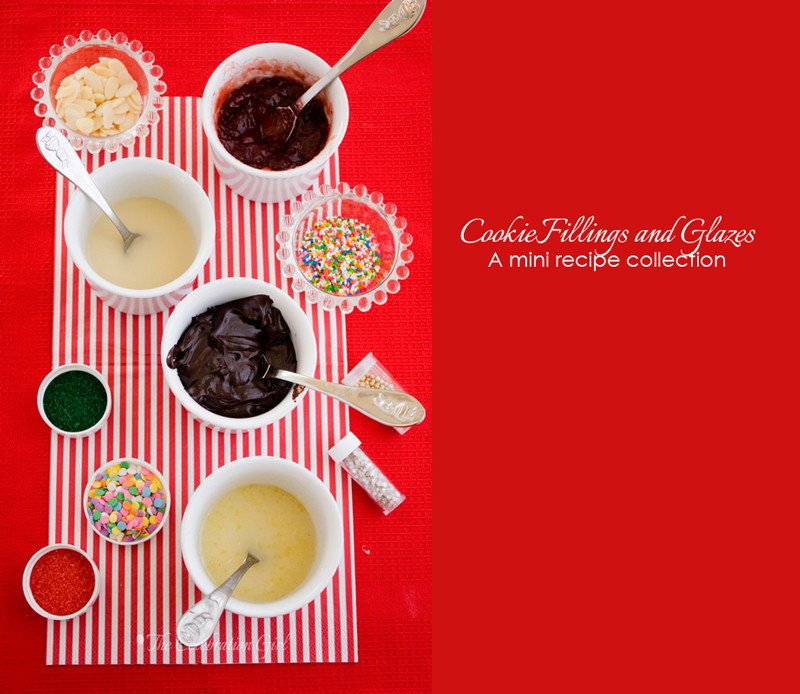
Good morning dear friends! Day 6 of the advent, almost 1 week into the season already and the weekend is almost here!
Today’s post is, in fact, the first part of a longer post that will be completed tomorrow, when we continue playing with the cookies we made before . These are some of the recipes I will be using and, for brevity sake and not to make one post super long, I thought it better to divide it in two. So, here are some of my favorite glazes and fillings to go with the cookie doughs I shared with you on Day 3.
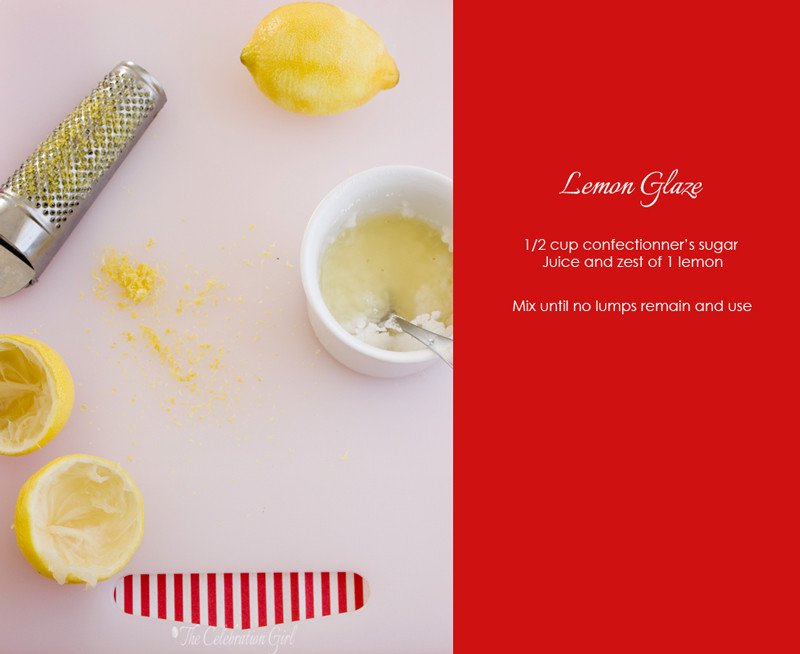
I also like to glaze my cookies with an orange glaze. In order to make it, use juice and zest of an orange instead of that of a lemon, in the same quantities and in the recipe above.
When I want to make a more traditional unflavored sugar Sugar glaze, I mix 1/2 cup confectioner’s sugar, 1 tablespoon warm water, 1 teaspoon of golden syrup and 1 teaspoon vegetable oil until no lumps remain. Traditionally this glaze uses melted butter but, as I have mentioned before, I prefer to skip using dairy as much as possible due to my son’s mild intolerance.
This a great filling, especially for almond or hazelnut shortbread cookies. There is something about pairing nuts and chocolate that is just heavenly perfect. I use coconut cream when I want to make a dairy free version, keeping the quantities stable.
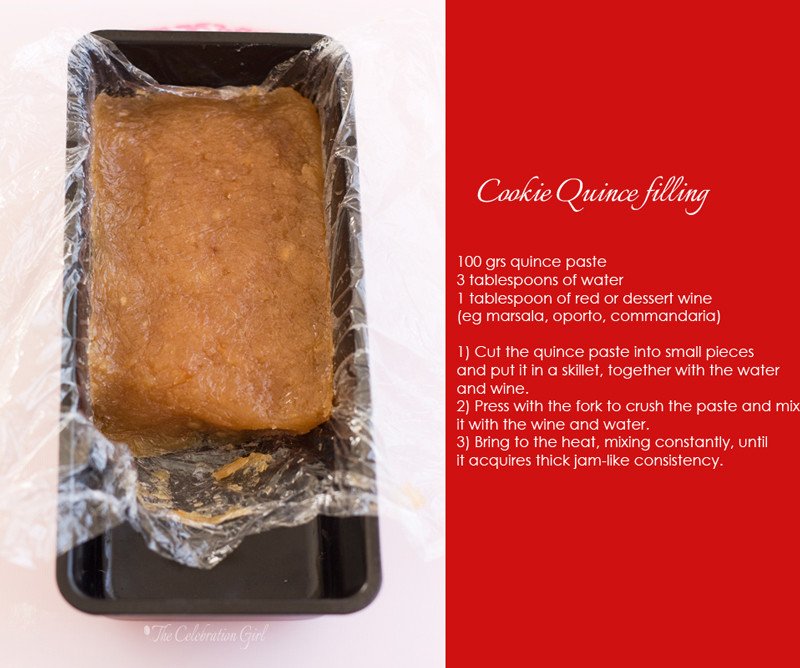
Quince paste or “Dulce de Membrillo”, as we call it back home, is a staple food in most Argentinian homes (or at least it was in mine when I was growing up), but outside of Argentina it isn’t that easy to find. A friend of my mother’s recently shared with me this wonderful recipe and I put it in use, taking advantage of quince season, with the idea of making the famous pastafrola. However, when I thought about fillings for the advent’s cookies, I realized that quince paste would make a wonderful one. I gave it the necessary jam-like consistency using the same method I use for making pastafrola’s filling (quantities vary, though). Here you have it:

So, get those fillings and glazes ready, because we will be using them tomorrow!
What are your favourite sugar cookie fillings and glazes?
Con sabor latino…
Buenos días queridos amigos! Es el 6to día del adviento, ya ha transcurrido casi una semana de la temporada festiva y el fin de semana nos pisa los talones.
El post de hoy es, en realidad, la primera parte de un post más largo que completaré mañana, cuando continuaremos jugando con las galletitas que horneamos anteriormente. Estas recetas son algunas de las que usaré mañana, así que para no hacer un solo post larguísimo, decidí dividirlo en dos. Aquí tienen, entonces, algunos de mis rellenos y baños favoritos para las galletas que compartí con ustedes el 3er día del adviento:
1) Glaseado de limón: Mezclar 1/2 taza de azucar impalpable con el jugo y la ralladura de 1 limón, revolviendo bien hasta que no queden grumos.
2) Glaseado de naranja: Mezclar 1/2 taza de azucar impalplable con el jugo y la ralladura de una naranja. Revolver bien hasta que no queden grumos.
3) Glaseado de azucar: Mezclar 1/2 taza de azucar impalplable con 1 cucharada de agua caliente, 1 cucharadita de golden syrup (azucar invertido) o syrup de maiz y una cucharadita de aceite vegetal, revolviendo hasta que no quede ningun grumo. Tradicionalmente, esta receta lleva manteca pero yo uso aceite a causa de la leve intolerancia a los lacteos de mi hijo.
4) Relleno de crema de chocolate: Colocar 60 grs de chocolate amargo en un bowl. Llevar 1/3 de taza de crema de leche al fuego, retirar cuando rompa el hervor y verter sobre el chocolate, dejando que éste se disuelva. Una vez casi completamente disuelto, batir vigorosamente hasta obtener una crema. Agregar 2/3 tazas de azucar impalpable y mezclar bien, hasta que no queden grumos. Si quieren hacerla sin lacteos, reemplacen la crema de leche por crema de coco.
5) Dulce de membrillo casero: Lavar y cepillar 2 membrillos y colocarlos en una olla con agua hirviendo durante 10 minutos. Retirar, dejar enfriar, pelar y procesar. Pesar la pasta resultante, que tiene que dar aproximadamente 500 grs. Agregar 400 gramos de azucar granulada comun (si es menos o mas, ajustar la cantidad proporcionalmente), cubrir con papel film y dejar reposar toda la noche. Al día siguiente, colocar en una olla de hierro, tipo Le creuset o essen, y llevar a fuego revolviendo constantemente con cuchara de madera hasta que la pasta se desprenda del fondo y de los bordes. Cubrir un molde de budin con papel film, verter dentro la pasta de membrillo, apretando con una cuchara para que quede compacta. Cubrir la pasta con papel film, bien al ras y asegurandose que no queden burbujas de aire. Dejar reposar en la heladera.
6) Pasta jalea de membrillo (para rellenar galletitas): Cortar 100 grs de membrillo en trozos y colocar en una sarten, junto con 3 cucharadas de agua y 1 cucharada de vino tinto o de postre. Pisar con tenedor para ablandar la pasta e integrarla con los líquidos. LLevar a fuego, pisando y revolviendo constantemente, hasta que adopte una consistencia de mermelada bien espesa.
Ya lo saben: vayan preparando estos rellenos y glaseados, que mañana comenzaremos a usarlos!
Y de paso, cuentenme, cuales son sus preferidos?
by Marcela M. | Dec 4, 2012 | Blog, Christmas and NYE, cookies, Holidays, Recipe Box, Recipes, Sweets

Good morning friends! It’s day 4 of the advent, and it’s only 20 days until Christmas eve, can you believe it? I know it’s a real cliché, but I have no idea where time went this year. Let’s make the most of this last month, shall we?
I hope you have your cookie doughs ready because we are going to put them to good use today. So, take them out of the freezer or refrigerator and gather your cookie cutters, a few sugar pearls and nonpareils because we will start making pretty cookies for your assorted cookie box.
We will start by the simpler cookies and, in following posts, I will show you other techniques and ideas and we will increase difficulty as we go. As I have mentioned before, I want to encourage you to bake with your children and, for this reason, I decided to include easy cookies that you can make even with toddlers. When baking with small children, though, I would recommend you to bear in mind two things: 1) Forget about the mess and about the end result. You can always bake perfect cookies later. Baking with children is more about having fun and letting them be creative in the kitchen, letting them familiarize themselves with the tools of the craft and about sharing special moments, building memories. 2) Make extra dough, because they will soon discover that unbaked cookie dough tastes delicious!
I used a few of the cookie cutters I had, just to give you an idea but, as you will soon discover, many more combinations are possible. You could also dye some of the dough in red or green or whatever color you are using for your party and thereby increase the possibilities. Also, for the cookies to keep their shape, refrigerate, refrigerate, refrigerate! Do not skip this step!
Here are some ideas:
1) Candy cane cookies: There are no pictures of the finished product because my children ate them before I could take pictures (ahem) but they look the same as the one you see already shaped in the picture above. I used vanilla and chocolate sugar cookie doughs, but you could use other combinations, for eg: gingerbread and vanilla, orange and chocolate, plain vanilla and red dyed dough, etc. Making them is very easy: take a small piece of each dough between you hands and shape them as cilinders.Place them next to each other and braid them. Roll the resulting bi-color cilinder a couple of times, to integrate it, and then twist down the upper part, forming a cane. Cut the ends to keep them even. Put in the freezer for 20 minutes and bake.
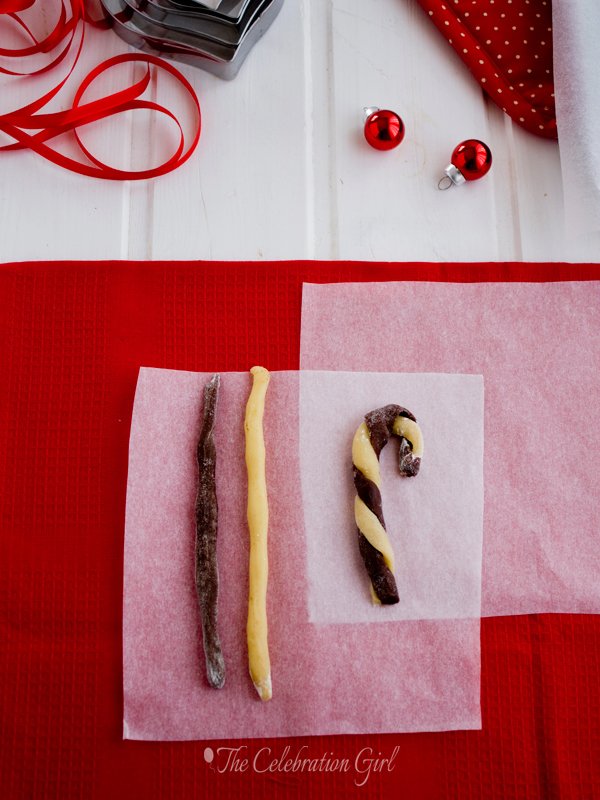
2) Marbled cookies: Take two pieces of dough of different colours, join them by the side and twist a few times. Don’t overdo it or they will merge and you will a have dough in a lighter version of the darker color, not a marbled one. Roll, cut, refrigerate and bake.
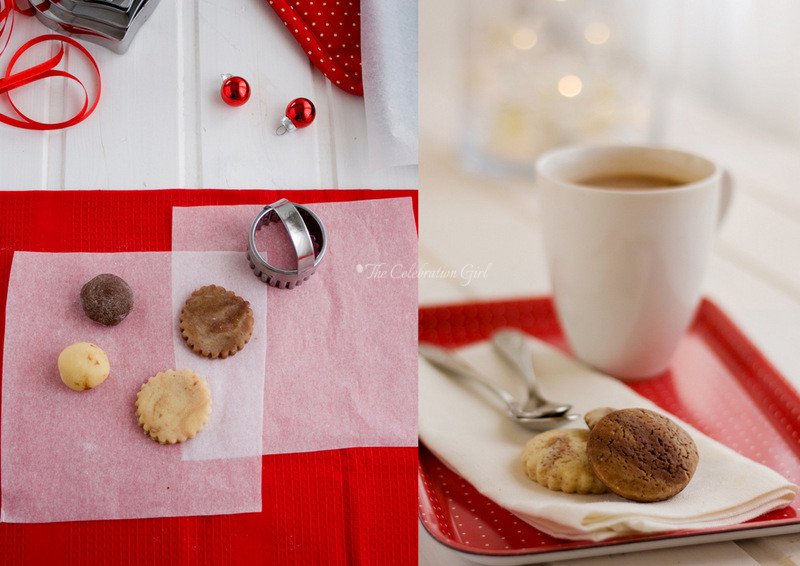
3) Cut out cookie combinations: To make these cookies you will need 2 cookie cutters of the same shape, but different sizes. Roll your cookie doughs and cut a shape with the bigger cutter. Place it in the baking tray and, once there, cut a smaller shape from the same cookie, leaving a “hole” inside. You need to do this when the big cookie is already in the baking tray or it may break or lose shape when transferred. Cut a big cookie of a different color, and repeat the process. Then mix and match the insides. They will merge in the oven and attach to the bigger cookie. Another option that I didn’t have the time to photograph but looks really pretty is to insert crushed hard candy in the hole, to get a vitreau effect. Note: If you don’t have cookie cutters, you can use other utensils. In the past I have used the lid of a marmalade jar to trace a big circle and the lid of a vanilla extract jar to trace the small one.
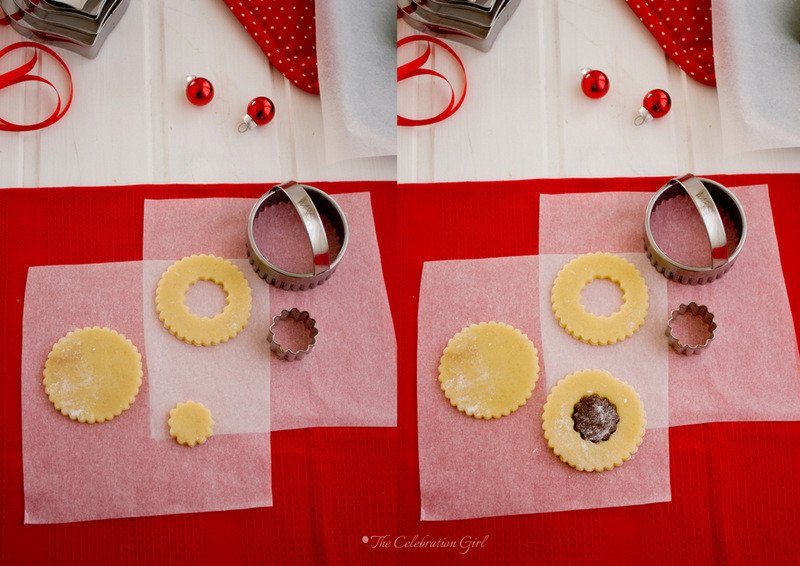

4)3D shape cookies: Cut a small shape in a different color than that of the main cookie, brush it with water and place it on top of the big cookie before baking. They will get attached once baked.
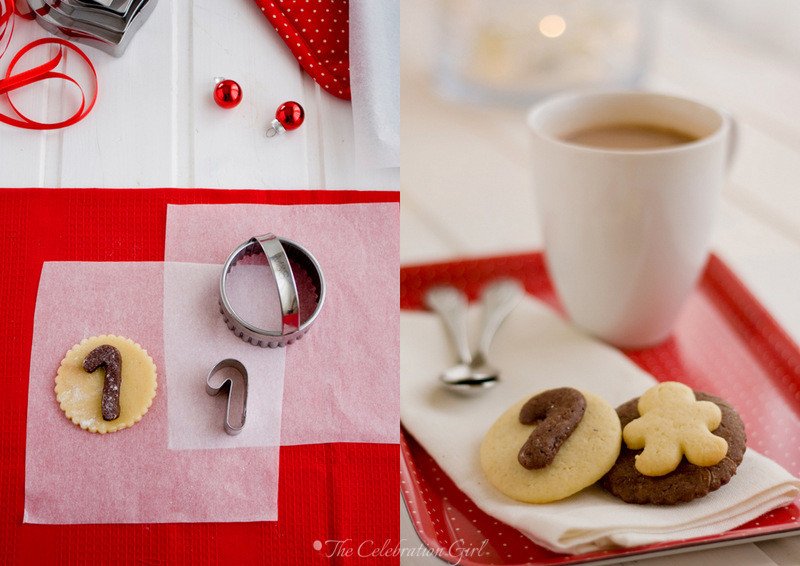
5)Sugar pearls decorated cookies: Did you know that sugar pearls can be added without glaze or icing? They can! Just play with the design and attach them before baking by pressing them lightly into the dough.
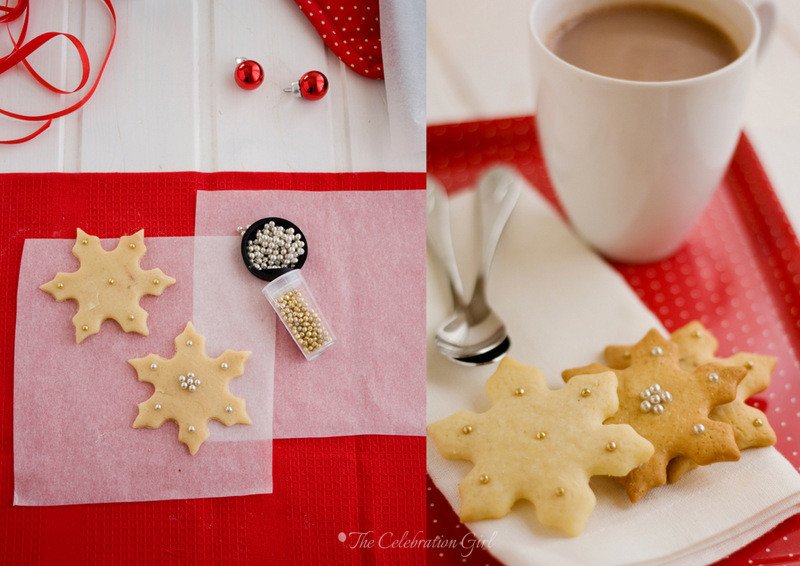
6) Cookie “Truffles”: No, they are not truffles, but they look like them before baking, don’t they? In order to make these cookies, make small balls of dough and roll them in non pareils, sugar pearls, or a combination of 1 tablespooon of sugar, 1/4 teaspoon of cinnamon and a pinch of cardamom before baking. They will expand in the oven,but the colder they are when you start baking them, the more they will keep their shape.
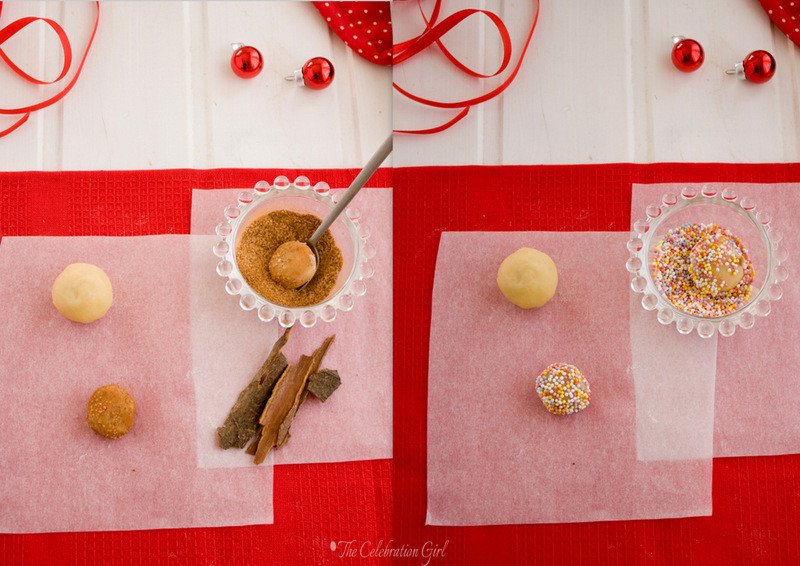
7) Thumbprint cookies or “Pepas”: Pepas is how we call these type of cookies in Argentina and they are normally filled with a square of quince paste, which is a staple food in many Argentinian households (mine is home made, recipe coming soon!). I prefer to make them using the almond shortbread dough, and I like to vary the fillings, using nutella or caramel as well as quince. To make them, roll a ball of dough and press with your thumb (hence the name) or index finger to create a well in the middle. Fill the well with the jam or sweet paste of your choice and bake.
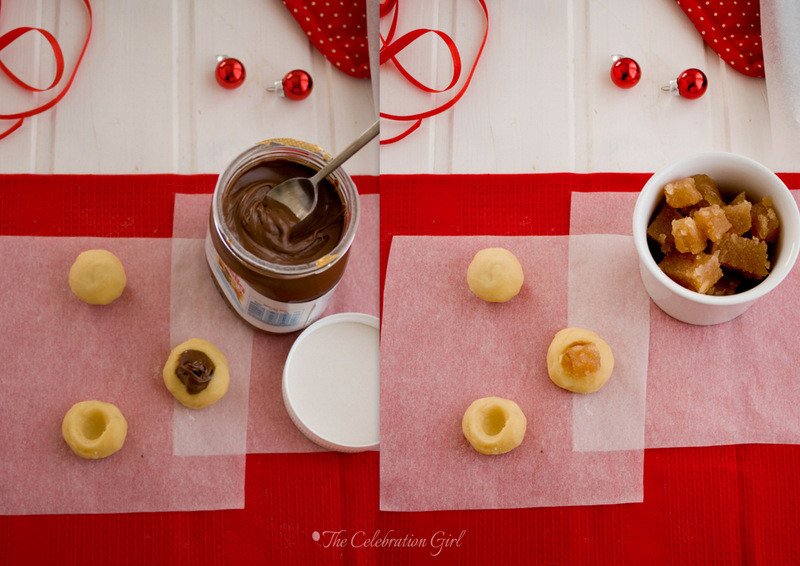
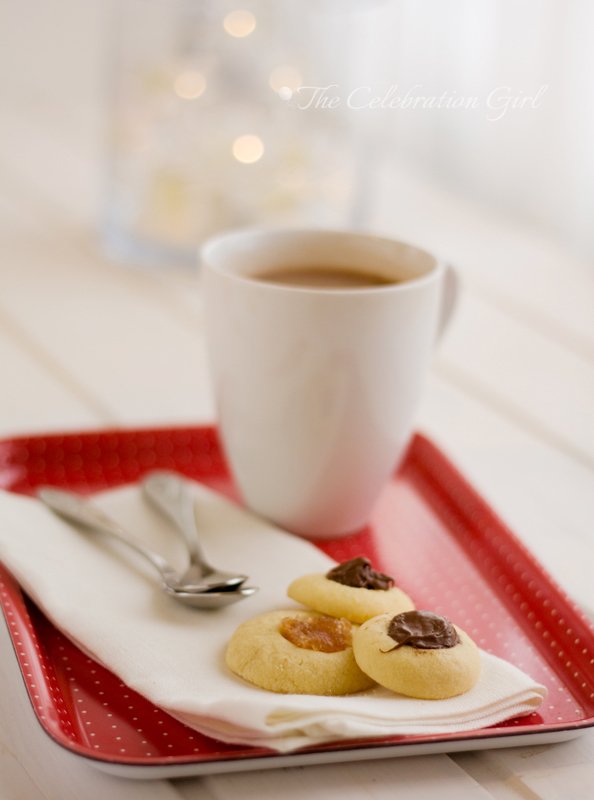
Are you ready to start baking?
Con sabor latino…
Buenos días queridos amigos! Hoy es el 4to día del adviento y faltan sólo 20 días para la nochebuena ¿Pueden creerlo? Sé que lo que voy a decir es un cliché, pero realmente no sé en qué momento pasó el año. Seamos conscientes de la velocidad a la que pasa el tiempo y aprovechemos al máximo este último mes de 2012, si?
Espero que tengan listas las masas de galletitas que compartí con ustedes ayer, porque hoy vamos a usarlas. Así que saquenlas del freezer o heladera y junten sus cortantes, granas, perlas y azucar decorativo porque vamos a comenzar a hacer lindas galletitas surtidas para sus cajitas navideñas.
Hoy vamos a comenzar con las galletitas más fáciles y, en posts sucesivos, les voy a ir mostrando otras maneras de decorarlas, en orden de complejidad creciente. El motivo por el que incluí estas galletitas tan sencillas es porque quiero incentivarlos a cocinar con niños, y estas pueden hacerse aún con los más chiquitos. Ahora bien, al cocinar con niños pequeños, es bueno tener dos cosas en mente: 1) Olvidense del orden y del resultado final. Dejenlos crear. Si queremos galletitas perfectas, podemos hacerlas nosotros solos cuando ellos duermen. Dejemos que cocinar con niños sea un acto creativo, orientado a pasar un momento divertido juntos, a que se familiaricen con los instrumentos de cocina, a que le “agarren el gusto”a cocinar, a construir recuerdos familiares hermosos. 2) Hagan masa extra, porque los chicos son vivísimos y se dan cuenta MUY pronto que la masa de galletitas cruda es deliciosa!
En este post yo usé algunos cortantes que tenía en casa, a modo de ejemplo, pero como verán son posibles muchísimas combinaciones más. Tambien pueden, por ejemplo, teñir parte de la masa de vainilla de otro color, como rojo o verde o cualquier otro que vayan a usar en la decoración, aumentando así las posibilidades creativas. Recuerden, eso sí, que para que las galletitas mantengan su forma es fundamental refrigerarlas, refrigerarlas, refrigerarlas! No omitan este paso!
Ahora sí, vamos a las ideas:
1) Galletas “baston”: No tengo fotos del producto combinado porque mis hijos se las comieron antes que pudiera sacarlas (ejem), pero se ven iguales a la foto del bastoncito armado antes de hornear. Yo usé masas de vainilla y chocolate, pero tambien podrian usar otras combinaciones, como vainilla y gengibre, chocolate y naranja o teñir parte de la masa de rojo y combinarla como un baston de caramelo tradicional. Para hacerlas, tomen una poco de masa de cada color y denle forma de cilindro. Coloquen los dos cilindros, uno al lado de otro, unanlos en la parte de arriba y comiencen a trenzarlos hacia la derecha, pasando la masa de la izquierda por encima de la de la derecha. Una vez trenzados, haganlos rodar un par de veces para que no queden junturas y doblen la parte superior hacia abajo. Corten los bordes para que queden parejos, coloquen en una placa, refrigeren y horneen.
2) Galletas marmoladas:Tomen dos pedacitos de masa de diferentes colores, unanlos por el costado y retuerzanlos un par de veces. No retuerzan mucho o en lugar de galletitas marmoladas tendrán simplemente una masa de color más claro que la oscura. Estiren con palote, corten, coloquen en una placa, refrigeren y horneen.
3) Galletas combinadas: Para hacer estas galletitas necesitarán dos cortantes de igual forma pero de distinto tamaño. Hacerlos es muy sencillo: estiren una de las masas con palote y corten galletitas con el cortante más grande. Coloquen las galletitas en la placa y, una vez allí, usen el cortante pequeño para sacar una galletita mas pequeña del centro de la más grande. Les sugiero hacerlo una vez que la galletita grande ya esté en la placa porque, de lo contrario, ésta puede romperse o perder la forma al transferirla ya cortada. Luego, repitan el proceso con la masa del otro color e inviertan los centros. Las dos partes se unirán al hornear, dejandoles una galletita divertida de dos sabores y colores. Otra opción muy linda que no tuve tiempo de fotografiar es colocar caramelo duro picado (destrozado con mortero) en el hueco, para lograr un efecto vitreau. Nota: si no tienen cortantes de galletitas, pueden usar otros instrumentos de cocina. En el pasado yo he hecho estas galletitas usando la tapa de un frasco de mermelada para el circulo grande y la tapa de un frasco de esencia de vainilla para el más pequeño.
4) Galletas con formas en 3D: Sencillísimas, sólo hay que cortar una formita en un color de masa diferente al de la galleta principal, y pegarla con agua a la más grande antes de hornear ( Se unirán en el horno)
5) Galletas decoradas con perlas de azucar: ¿Sabían que no hace falta glasa ni glacé para pegar perlas de azucar? Pues así es! Solo tienen que colocarlas sobre la masa cruda, conforme el diseño que prefieran, y presionar apenas con el dedo sobre las mismas para insertarlas en la masa. Luego refrigeren, horneen y listo.
6) “Trufas”de galletita: No, no son verdaderas trufas pero lo parecen antes de ser horneadas, no? Para hacerlas, hagan una bolita de masa, y ruedenla en granas, nonpareils, perlas de azucar o en una combinación de 1 cucharada de azucar, 1 cuarto de cucharadita de canela molida y 1/8 de cucharadita de cardamomo. Se expandirán en el horno, pero tienden a conservar mejor la forma cuanto más fría está la masa.
7) Pepas: Estas galletitas son muy comunes en Argentina, rellenas con un cuadradito de dulce de membrillo (que es un clásico de nuestra gastronomía). Mi dulce de membrillo es casero y la receta será publicada pronto! Yo prefiero hacer estas galletitas con la receta de las galletitas mantecosas de almendra, que compartí con ustedes ayer, combinando distintos sabores para el relleno. El clásico membrillo, nutella o salsa de caramelo quedan deliciosos. Para hacerlas, hagan una bolita de masa y, luego, presionen con el pulgar o el índice para ahuecar la masa en el centro, y rellenen el mismo con el dulce o mermelada deseado. Refrigeren, horneen, y listo!
Estan listos para empezar a hornear?
by Marcela M. | Dec 3, 2012 | Blog, Christmas and NYE, cookies, Cooking basics and tutorials, Holidays, Recipe Box, Recipes, Sweets
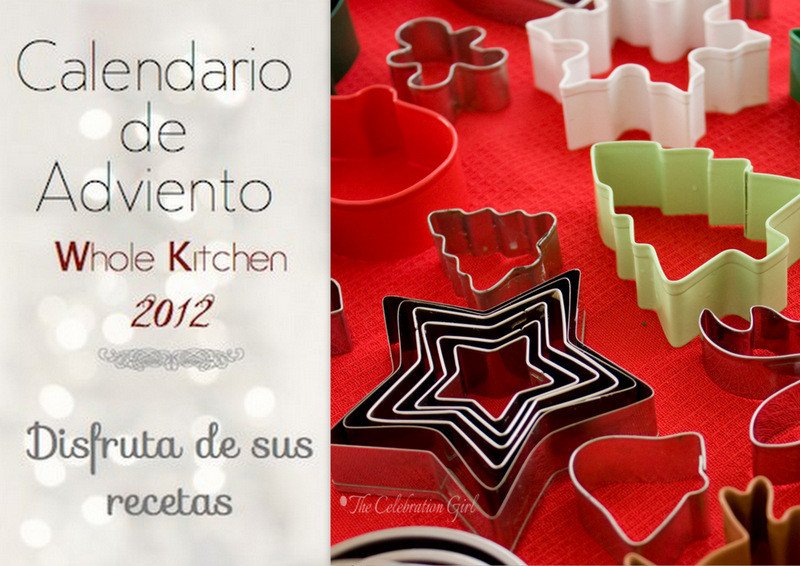
Good morning friends! I hope you had a lovely weekend!
Today’s post participates in Whole Kitchen’s 2012 Advent calendar . A few days ago, Silvia contacted me to offer me to participate in it and I, of course, accepted! So today, get your aprons ready because we start baking! (Amigos hispanoparlantes, el texto en español está al final del post!)
I thought it was best to begin the holiday baking season with the basics: 3 simple cookie recipes and a few explanations on how to adapt they are adapted. I wanted to give you my staple recipes, the ones that are simple enough to make in whim, yet delicious, reliable and versatile to allow multiple modifications. In following posts, I will show you a few ideas for combining and decorating them, with varying degrees of difficulty, so that you can make a box of assorted cookies without spending days in the kitchen.
Let’s get started!
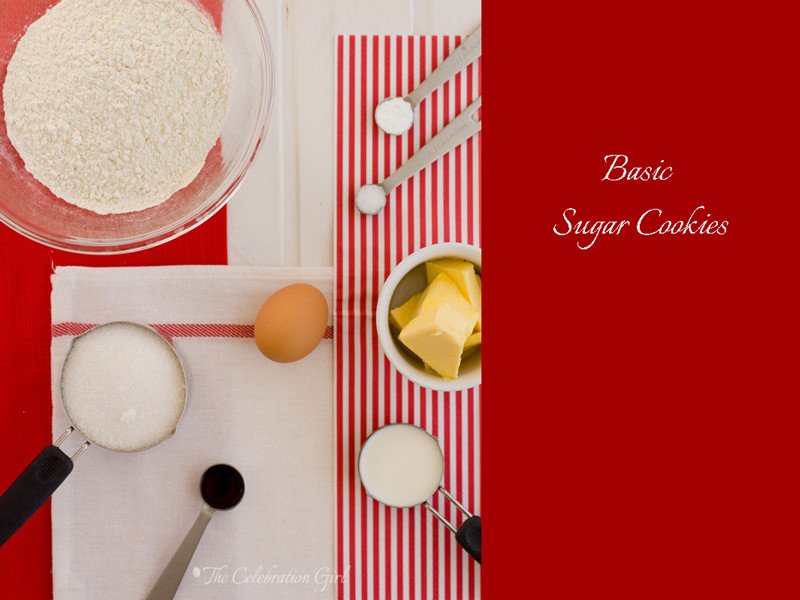
The first recipe is for the all time classic Sugar Cookie. The first time I made them was just a few years ago, inspired by some of my favorite bloggers and following to the letter the recipe for Martha Stewart’s Ideal Sugar Cookies. As time went by, I introduced a few little modifications: I normally double the amount of vanilla and, if baking with my children, who love to spread flour everywhere, I add more milk than usual to prevent the cookies from becoming too hard once baked. Also, since my son doesn’t tolerate dairy products too well, I frequently use margarine instead of butter, and vegetable milk instead of cow’s milk. The texture is different when baking with margarine, but the recipes turn out delicious nonetheless. One important note, though, is that margarine should not be beaten extensively or the final product becomes oily (and we don’t want that!). So, if that’s what you are using, cream it with sugar for a maximum of 3 minutes.
Take this as your basic recipe, and then start playing with it. You could use it as a basis for making sugar orange or lemon cookies, for example, by simply adding a teaspoon of orange or lemon zest and replacing the milk for lemon or orange juice, or you could make coffee flavored cookies by replacing 1 teaspoon of the milk for espresso. The possibilities are really endless. Just make sure that you maintain the balance between liquid and dry ingredients and that your replacements respect the original ratios.
Here’s the basic recipe (adapted from Martha Stewart):
Ingredients: 2 cups all purpose flour, 1/4 tsp salt, 1/2 tsp baking powder, 113 grs butter (1/2 cup) or margarine , 1 cup sugar, 1 beaten egg, 4 tbp milk or 1/4 cup milk ( this is the amount I use when I bake with my children because I know they will add too much flour when rolling and cutting. Please note that Martha’s original recipe calls for 2 tablespoons only), 1 teaspoon vanilla extract.
Preparation: 1) Pre heat the oven to 175 C. 2)Cream butter and sugar until the butter becomes almost white. Note that if you are using margarine, you should cream it for a maximum of 3 minutes 2) Add milk, vanilla and the beaten egg. Incorporate. 3) Whisk or sift together the dry ingredients: flour, salt and baking powder and add them to the batter, making sure not to overmix. 4) Extend plastic wrap on the kitchen’s counter, pour the dough in it, wrap it and refrigerate for a couple of hours. If you are baking this cookies in the summer and you live in very hot climates, I recommend putting it in the freezer for 1 hour instead. 5) When you are ready to bake the cookies, flour the kitchen counter, and roll using a rolling pin, considering that thicker cookies are moister and chewier, and thinner cookies are crispier. Cut the cookies using a cookie cutter or a knife, place on a baking sheet covered in baking paper and refrigerate. Do not skip the refrigerating step or your cookies will lose shape in the oven! I normally place them in the freezer for 20 minutes before baking. 6) Bake for 10-15 minutes. Do not let them brown.Let cool on a wire rack and eat or decorate.

Now let’s say you want to make chocolate sugar cookies instead, how do you adapt the basic recipe? It’s also very simple. As you can see from the pictures above, most ingredients remain the same, and a few new ones are added, namely cocoa, brown sugar and an extra egg to make up for the added dryness. Remember, it is a matter of ratios and balance between the different ingredients. Cocoa is a dry ingredient, so it counts as if we had increased the amount of flour. Brown Sugar gives the recipe a darker color, a stronger flavour (because it contains molasses) and, as sugar in general, acts as a binding agent. Having added these two ingredients, the recipe would be too dry if you didn’t add an extra egg, but if you prefer to keep the quantities intact and you don’t want to add an extra egg, you could do so by reducing 20% of the flour and replacing it by cocoa, and replacing 1/3 of the granulated sugar and replacing it with brown sugar. That is really all it takes.
Here’s the recipe (as I normally do it)
Ingredients: 2 cups flour, 1/2 cup cocoa, 1/2 tsp baking powder, 1/4 tsp salt, 113 grs butter or margarine, 1 cup granulated sugar, 1/3 cup brown sugar, 2 beaten eggs, 2 teaspoons milk, 1 teaspoon vanilla.
Preparation: 1) Pre heat the oven to 175 C. 2)Cream butter and the two sugars until light and fluffy. Note that, if you are using margarine, you should cream it for a maximum of 3 minutes 2) Add milk, vanilla and the beaten eggs. Incorporate. 3) Whisk or sift together the dry ingredients: flour, cocoa,salt and baking powder and add them to the batter, making sure not to overmix. 4) Extend plastic wrap on the kitchen’s counter, pour the dough in it, wrap it and refrigerate for a couple of hours. If you are baking this cookies in the summer and you live in very hot climates, I recommend putting it in the freezer for 1 hour instead. 5) When you are ready to bake the cookies, pour cocoa powder on the kitchen counter. I prefer to use cocoa instead of flour when making chocolate cookies because this prevents them from getting a white coat and accentuates the flavor 6) Roll using a rolling pin, considering that thicker cookies are moister and chewier, and thinner cookies are crispier. 7) Cut the cookies using a cookie cutter or a knife, place on a baking sheet covered in baking paper and refrigerate. Do not skip the refrigerating step or your cookies will lose shape in the oven! I normally place them in the freezer for 20 minutes before baking. 8) Bake for 10-15 minutes. Do not let them brown.Let cool on a wire rack and eat or decorate.
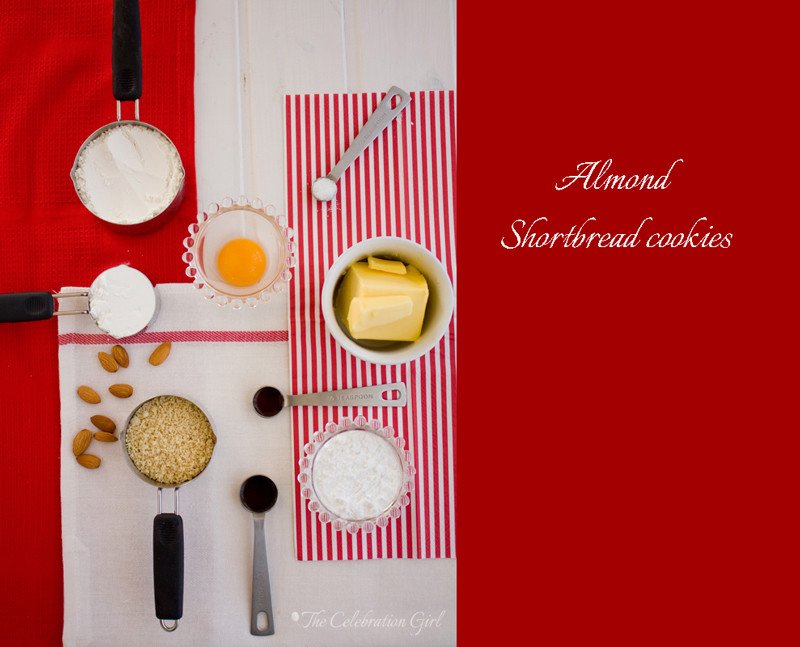
Today’s final recipe is another holiday classic, shortbread cookies, that I have adapted by including finely ground almonds in it. The main difference between sugar and shortbread cookies lies in the proportion between butter and sugar: Sugar cookies use double the amount of sugar than that of butter, and in shortbread cookies this ratio is reversed. Notice also that, in this recipe we also reduce 1/8 of the amount of dry ingredients (almonds count as dry ingredients and so does cornstarch) and that there’s a correlative reduction in the wet ingredients: instead of one egg, we use only an egg yolk and we omit the milk altogether. These cookies don’t require baking powder either, so they won’t rise. The result is a richer cookie, with a softer flavor, ideal for combining with fillings and chocolate.
As I mentioned before, I have modified this recipe by using almonds and almond extract, but you could omit them and use only flour, or replace these with other nuts (hazelnuts are also delicious).
Here’s my recipe for Almond shortbread cookies:
Ingredients: 1 cup flour, 1/2 cup finely ground almonds, 1/2 cup icing sugar, 1/4 cup cornstarch, 1/4 tsp salt, 113 grs butter, 1 egg yolk, 1/2 teaspoon vanilla, 1/2 teaspoon almond extract
Preparation: 1) Put the finely ground almonds, flour, cornstarch, salt and icing sugar in the food processor and pulse until combined. 2) Add the wet ingredients and pulse until the dough separates from the bowl 3) Remove the dough from the food processor and knead it on the counter. 4) Cover in plastic wrap and refrigerate for two hours. 5) Pre heat the oven to 175 C. Remove the dough from the refrigerator, roll on a floured surface and cut in the desired shapes. Place the cookies on a baking sheet lined with baking paper and bake for 10-15 minutes. Let cool on a wire rack and eat or decorate.
Tomorrow I’ll start showing you some ways in which you can play with these recipes!
Now, please tell me: Do you bake cookies for the holidays? What are your favorite recipes? Do you like to decorate them and, if so, how do you do it?
Have a lovely Monday!
Con sabor latino…
Buenos días queridos amigos y bienvenidos sean todos aquellos nuevos lectores que llegan desde Whole Kitchen! Espero que hayan pasado un hermosísimo fin de semana.
El post de hoy participa en el Calendario de Adviento 2012 de Whole Kitchen . Hace unos días, Silvia me contactó para preguntarme si quería participar en el mismo y yo, por supuesto, acepté! Así que preparen sus delantales, porque hoy vamos a hornear!
Para inaugurar la temporada de cocina de la época navideña, pensé que sería mejor empezar por la base: 3 recetas simples y un par de explicaciones acerca de cómo introducir variaciones a las mismas. Quise compartir con ustedes aquellas recetas a las que vuelvo una y otra vez, aquellas que son lo suficientemente simples como para hacer en menos que canta un gallo, a la vez que confiables, deliciosas y versátiles como para permitir que cada uno deje volar su creatividad. En posts sucesivos voy a mostrarles ideas de cómo combinarlas y cómo decorarlas con distintos grados de dificultad, para que estas fiestas puedan tener una caja de galletitas variadas sin necesidad de pasar horas y horas en la cocina.
Comencemos!
La primera receta que quiero compartir con ustedes es la de las clásicas galletitas de azucar. La primera vez que la hice fue apenas unos años, y en esa ocasión y muchas otras, seguí al pie de la letra ESTA receta de la inigualable Martha Stewart. A medida que el tiempo pasó, fui introduciendo algunas modificaciones, por ejemplo suelo duplicar la cantidad de vainilla y, si preparo la receta con mis hijos, suelo duplicar la cantidad de leche porque tienden a agregar mucha harina cuando estiran la masa y me ha ocurrido que si sigo la receta al pie, quedan un poco duras. Tambien suelo hacerlas con margarina y leche vegetal porque mi hijo, sin llegar a ser alergico, nunca a tolerado muy bien que digamos los lacteos. Debo aclarar que la textura resultante es un poco diferente cuando uno trabaja con margarina, pero creanme que son deliciosas de todas maneras. Una advertencia importante, sin embargo, es que la margarina no debe batirse mucho tiempo con el azucar, como hacemos con la manteca, porque si no las galletas resultaran oleosas. Si usan este ingrediente, recuerden no batirla más de 3 minutos.
Les sugiero tomar esta receta como base y luego experimentar con otros sabores. Por ejemplo, si quieren hacer galletitas de limon o de naranja, pueden agregar una cucharadita de té de ralladura de limón o naranja, y reemplaza la leche por jugo de limón o naranja. Si quieren hacer galletitas de café, pueden reemplazar una cucharada de leche por una de café espresso…y así sucesivamente. Las posibilidades son enormes! Sólo tengan en cuenta que, para que la receta resulte bien, es necesario mantener el equilibrio entre los ingredientes secos y líquidos, y que los reemplazos mantengan las raciones originales.
Esta es la receta para las galletitas de azucar básica (adaptada de Martha Stewart)
Ingredientes:2 tazas de harina todo uso, 1/4 cucharadita de sal, 1/2 cucharadita de levadura química (Polvo de hornear Royal), 113 grs de manteca o margarina vegetal, 1 taza de azucar blanca, 1 huevo batido, 4 cucharadas o 1/4 taza de leche (puede ser vegetal. Tengan en cuenta que la receta original sólo requiere dos cucharadas y que yo sólo la duplico porque mis hijos tienden a agregar demasiada harina luego. Si no cocinan con niños o si sus niños son disciplinados al agregar harina, es mejor mantener la cantidad original), 1 cucharadita de vainilla.
Preparación: 1) Bata la manteca pomada con el azucar hasta que la preparación resulte en una crema blancuzca y esponjosa 2) Agregue leche, vainilla, y el huevo batido e incorpore 3) Mezcla con batidor de alambre o cierna los ingredientes secos: harina, sal y levadura química, y agreguelos en dos veces. Mezcle sólo hasta que todos los ingredientes estén incorporados. 4) Envuelva la masa en papel film y lleve al refrigerador por al menos dos horas. Si están haciendo esta receta en verano o en climas muy cálidos, yo prefiero poner la masa una hora en el freezer. Es más facil trabajarla luego! 5) Cuando quiera hornear las galletas, retire la masa del freezer y estirela con palote sobre una superficie lisa. Tenga en cuenta que si la estira levemente gruesa las galletitas resultaran mas humedas, y si la estira finita, resultaran crocantes. 6) Corte las galletitas usando un cortante especial o cuchillo, colóquelas sobre una placa para horno cubierta con papel de hornear y refrigere. Es muy importante que no omita este paso! Si las galletitas no son refrigeradas pierden la forma en el horno! Yo suelo colocar la placa en el freezer durante 20 minutos para obtener mejores resultados. 7) Hornee a 175 C durante 10/15 minutos. No deje que tomen color (eso las vuelve duras). Deje enfriar sobre una rejilla y coma o decore.
Ahora bien, digamos que queremos hacer galletitas de chocolate ¿cómo transformamos la receta original? Es de verdad muy sencillo. Como pueden ver si comparan las dos primeras fotos, la mayor parte de los ingredientes se mantienen constantes y sólo se agregan tres: cacao, azucar morena, y un huevo más para compensar por las nuevas adiciones. Recuerden que modificar recetas es una cuestión de mantener proporciones y equilibrio entre los diferentes ingredientes. Como el cacao es un ingrediente seco, su adición cuenta como si hubieramos agregado harina. El azucar moreno cambia el sabor de la receta (porque contiene melaza), contribuye a que las galletitas tengan un color más oscuro y, como todo azucar en general, ayuda a que los ingredientes “liguen”. Habiendo agregado estos ingredientes, es necesario entonces sumar un huevo más para que la masa no resulte seca. Ahora bien, si prefieren usar uno solo (cuantas veces nos hemos encontrado con un solo huevo en la cocina, verdad? Yo,muchas!), modifiquen las cantidades de harina y de azucar blanca: reduzcan 20% la cantidad de harina y reemplacenla por cacao, y reduzcan 1/3 de la cantida de azucar blanca y reemplacenla por azucar moreno. Es tan sencillo como eso!
Esta es mi receta para galletitas de chocolate
Ingredientes:2 tazas de harina todo uso, 1/2 taza de cacao amargo, 1/4 cucharadita de sal, 1/2 cucharadita de levadura química (Polvo de hornear Royal), 113 grs de manteca o margarina vegetal, 1 taza de azucar blanca, 1/3 taza de azucar morena, 2 huevos batidos, 2 cucharadas de leche (puede ser vegetal), 1 cucharadita de vainilla.
Preparación: 1) Bata la manteca pomada con los dos azucares hasta que la preparación resulte esponjosa. Recuerden no batir más de 3 minutos si usan margarina 2) Agregue leche, vainilla, y los huevos batidos e incorpore 3) Mezcla con batidor de alambre o cierna los ingredientes secos: harina, cacao, sal y levadura química, y agreguelos en dos veces. Mezcle sólo hasta que todos los ingredientes estén incorporados. 4) Envuelva la masa en papel film y llevela al refrigerador por al menos dos horas. Si están haciendo esta receta en verano o en climas muy cálidos, yo prefiero poner la masa una hora en el freezer. Es más facil trabajarla luego! 5) Cuando quiera hornear las galletas, retire la masa del freezer y estirela con palote sobre una superficie lisa. Tenga en cuenta que si la estira levemente gruesa las galletitas resultaran mas humedas, y si la estira finita, resultaran crocantes. 6) Corte las galletitas usando un cortante especial o cuchillo, colóquelas sobre una placa para horno cubierta con papel de hornear y refrigere. Es muy importante que no omita este paso! Si las galletitas no son refrigeradas pierden la forma en el horno! Yo suelo colocar la placa en el freezer durante 20 minutos para obtener mejores resultados. 7) Hornee a 175 C durante 10/15 minutos. No deje que tomen color (eso las vuelve duras). Deje enfriar sobre una rejilla y coma o decore.
La última receta que les traigo hoy es la de otro clásico de está epoca: las galletitas de manteca o shortbread cookies, la que yo he modificado para transformarla en galletitas mantecosas de almendras. La diferencia principal entre las galletitas de azucar y las de manteca radica en la proporción entre estos dos ingredientes: las galletitas de azucar usan el doble de azucar que de manteca, y en las de galletitas de manteca esta proporción se invierte. Noten tambien que en estas galletitas reducimos 1/8 la cantidad de ingredientes secos, y teniendo en cuenta todo lo anterior (menos ingredientes secos y menos azucar), debemos reducir tambien los ingredientes líquidos, por lo que en lugar de un huevo entero usaremos sólo una yema, y omitiremos la leche. Las galletitas resultantes son más densas y de un sabor más neutro, no tan dulces,por lo que son ideales para combinar con rellenos y chocolate.
Como mencioné antes, yo he modificado la receta incluyendo almendras molidas en la misma. Si prefieren no hacerlo, pueden reemplazar la cantidad de las mismas por harina común (todo uso), bien pueden experimentar con otras nueces (yo las hecho tambien con avellanas molidas y quedan muy bien, por ejemplo).
Aquí está mi receta para galletas de almendras y manteca:
Ingredientes: 1 taza de harina, 1/2 taza de almendras molidas bien finitas, 1/4 taza de almidon de maiz (maizena), 1/2 taza de azucar impalpable, 1/4 cucharadita de sal, 113 grs de manteca, 1 yema de huevo, 1/2 cucharadita de extracto de vainilla, 1/4 cucharadita de extracto de almendras.
Preparación: 1) Coloque almendras, harina, sal, azucar y almidón de maiz en el bowl de la procesadora y pulse hasta que estén bien combinados. 2) Agregue todos los ingredientes húmedos (manteca, huevo y extractos) y pulse hasta que la masa se separe de las paredes del bowl. 3) Retire la masa de la procesadora y trabajela sobre la mesada hasta formar un bollo. 4) Envuelva la masa en papel film y lleve al refrigerador por dos horas. 5) Espolvoree harina sobre una superficie lisa, y estire la masa con palote. Corte de la forma deseada, coloque en una placa para horno cubierta con papel de hornear y hornee a 175 C por 10-15 minutos. No deje que tomen color. Deje enfriar sobre una rejilla y coma o decore.
Mañana comenzaré a mostrarles algunas formas en que pueden jugar con estas recetas.
Ahora cuentenme: ¿hornean galletitas para las fiestas? ¿cuales son sus recetas favoritas? ¿suelen decorarlas y de qué manera?
Que tengan un hermoso día lunes!
by Marcela M. | Oct 25, 2012 | Blog, cookies, Recipe Box, Recipes, Sweets
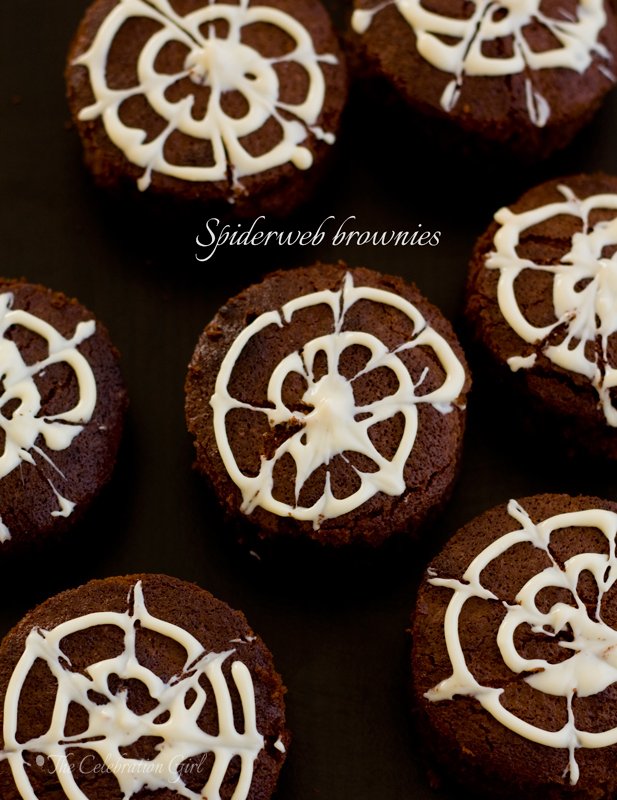
Chocolate…is there anything better? I didn’t think so 🙂
I love all types of chocolate, but my favorite is very dark (over 75%), which lots of people find slightly bitter but I adore. I love it because it is bitter, intense and because it is better enjoyed in small quantities, letting it melt slowly in the mouth. I love it on its own, in truffles, and also paired with vanilla, coffee, caramel, berries… well, with pretty much everything. This is why I smiled really widely when I saw that Circulo Whole Kitchen’s sweet recipe for October was none other than the all-classic brownie.
When it comes to brownies, it turns out, preferences vary greatly. I like my brownies moist, with a fudge-like interior and a crispy top, and I like them very chocolatey. Actually, I don’t like any other flavors to compete with that of chocolate, which is why I don’t add espresso, nor nuts, but lots of people do. The basic recipe, which is the one I bring you today, is very, very simple (which makes it very versatile) and it can also be used as a base for a cake, by adding filling and frosting (such as the traditinal brownie cake, that consists on a brownie base, topped with dulce de leche and frosted with Italian Meringue, which is then swirled with dark chocolate…truly decadent!)
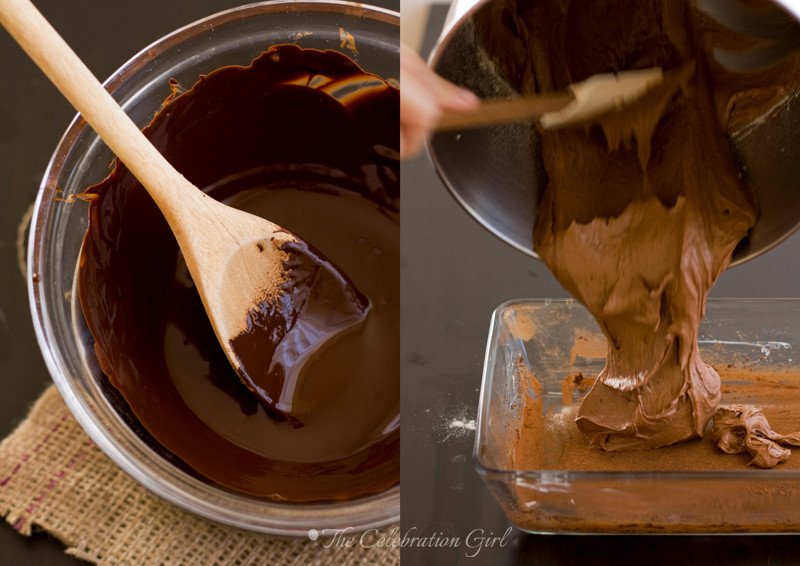
The ingredients are simple and straightforward: butter, sugar, dark chocolate, eggs and very little all purpose flour. Mix them, put the batter in the oven for just enough time for the brownies to cook, but not so much that they will get dry, cut, serve and enjoy! In this occasion, since Halloween is around the corner, I cut my brownies with a round shape (instead of the traditional square one) and added a small detail, a spiderweb, in white chocolate (see the picture tutorial below for instructions on how to achieve this look).
This is a great recipe to try with children, so why not get them involved in your Halloween preparations by making these brownies with them? Try it and let me know how it goes! I’m sure it will be fun!
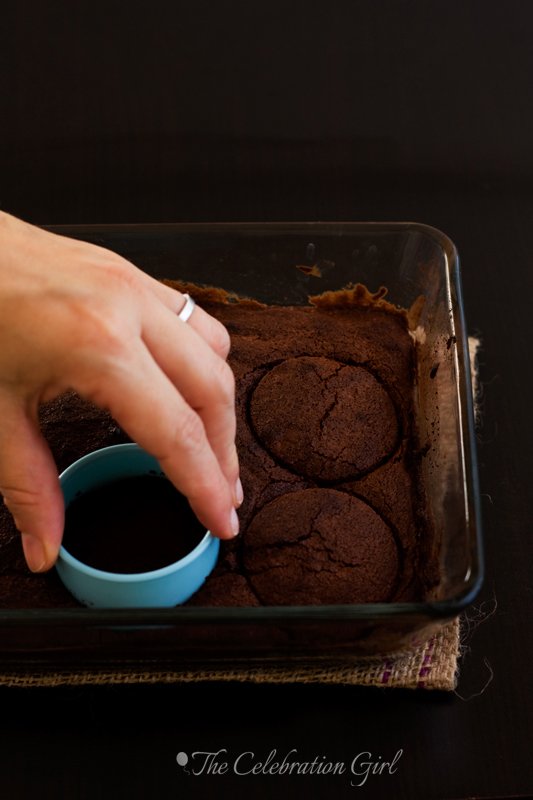
Here is the recipe:
Fudgy, chocolatey brownies with a crispy top
Ingredients: 100 grs butter, 100 grs sugar, 2 eggs, 1 teaspoon vanilla extract, 100 grs dark chocolate (at least 70%, the best you can get), 65 grs all purpose flour. If you are doing the spiderweb decoration, add 100 grs white chocolate.
Preparation: Pre-heat the oven to 200 C. Melt the dark chocolate in a double boiler or at “bain marie” and, let it cool down. Cream butter and sugar until white and fluffy. Add the eggs, one by one, and vanilla extract, incorporating well. Add the melted chocolate, incorporate and, finally, add flour. Grease a squared pan and dust it with cocoa (I prefer cocoa to flour when baking chocolate treats). Pour the batter in the pan and put it in the oven for 15 minutes, until the top starts to get crispy. Watch them carefully, don’t let them get dry! Remove them from the oven, let them cool slightly and cut in round shapes with a cookie cutter (as in the picture above).
Decoration: Melt white chocolate in a double boiler. Let it cool down and put inside a squeeze bottle (I use Wilton’s), or a piping bag with a size 3 tip. Pipe a white spiral on top of the brownie and, immediately after, drag the chocolate from the center to the outside, forming lines cut the spiral, and form the spiderweb (see the pictures below for a step by step visual explanation). Let the chocolate cool down and harden, and enjoy!

Con sabor latino…
Chocolate…hay algo mejor? No, verdad? Ya me parecía 🙂
Adoro todos los tipos de chocolate, pero sin dudas mi preferido es el amargo bien amargo, con al menos 75% de cacao. Me encanta ese sabor intenso que hace que haya que saborearlo de a poco, en pequeñas cantidades, dejando que se derrita lentamente en la boca. Me encanta en todas sus formas: solo, trufado, y junto con sabores que saben acompañarlo, como vainilla, café, caramelo o frutos del bosque, entre tantos otros. Es por ello que sonreí de oreja a oreja cuando leí que la propuesta dulce del Circulo Whole Kitchen para el mes de octubre era, nada más ni nada menos, que las clásicas y chocolatosas brownies.
Las preferencias en materia de brownies varian ampliamente. Las que me gustan a mí tienen una textura húmeda, muy chocolatosa (porque uso chocolate amargo), y un capa crocante arriba. Me gusta que el chocolate sea no sólo el sabor predominante, sino el único, por eso no agrego espresso ni nueces, como suelen hacer muchos. La receta que les traigo hoy es mi receta de base y es muy simple y, por lo tanto, muy versatil: pueden usarla no sólo como barrita, sino tambien como base de una torta a la que sólo deberán agregarle relleno y cobertura (como con la tradicional torta brownie, que tiene una capa de esta masa, sobre la cual se agrega dulce de leche, y se finaliza con copos de merengue italiano rociados con hilos de chocolate negro…terriblemente decadente!)
La receta es simple, y sencillos son sus ingredientes: manteca, azucar, huevos, y muy poquita harina común, los que se mezclan, se colocan en una fuente y se llevan a horno por el tiempo suficiente para que se forme la capa craquelada arriba pero no tanto como para que la masa se seque. Una vez cocidas, se sacan del horno, se cortan, y se disfrutan! En esta ocasión, y teniendo en cuenta que Halloween está a la vuelta de la esquina, usé un cortante redondo para darles forma (como pueden ver en la foto de más arriba), y agregué un pequeño detalle, una tela de araña dibujada con chocolate blanco (pueden ver el tutorial de cómo hacerlo, paso a paso, en las fotos que se encuentra inmediatamente encima de estas palabras).
Esta es una receta ideal para hacer con niños, porque es sencillísima, y porque a todos les encanta el chocolate! ¿Se animan a prepararla con ellos? Seguramente se divertirán muchísimo!
Aquí está la receta:
Brownies húmedas, chocolatosas y crocantes
Ingredientes: 100 grs de manteca, 100 grs de azucar, 2 huevos, 1 cucharadita de extracto de vainilla, 100 grs de chocolate amargo (el mejor que consigan, 70%), 65 grs de harina común. Si quieren hacer la decoración de Halloween, agreguen 100 grs de chocolate blanco.
Preparación: Pre caliente el horno a 200C. Derrita el chocolate blanco a baño maría y deje enfriar. Bata la manteca y el azucar a punto crema, hasta que quede una preparación blanca. Agregue los huevos de a uno, incorporando bien luego de cada adición. Agregue la esencia de vainilla e incorpore. Finalmente, agregue la harina de golpe, y mezcle bien asegurandose de tener una masa uniforme. Enmantece un molde y espolvoreelo con cacao (cuando hago masas de chocolate prefiero usar cacao amargo en lugar de harina para que no queden areas blancas al desmoldar). Vierta la mezcla en el molde y coloque en el horno por 15 minutos, o hasta que la capa superior se craquele apenas. Tenga cuidado de no pasarse con el horno, porque si se secan, las brownies no son ricas! Retire del horno, dejelas enfriar y corte con un cortante de galletitas redondo.
Decoración: Derrita el chocolate blanco y dejelo enfriar. Una vez tibio, coloquelo en una botella especial (yo uso Wilton) o bien en una manga pastelera con una boquilla numero 3. Dibuje un espiral de chocolate sobre el brownie y, luego, usando un palillo escarbadiente, arrastre lineas de chocolate que corten el espiral, desde el centro hacia afuera, cpmo en las fotos del collage que se encuentra arriba de este texto en castellano. Deje que el chocolate se enfríe y endurezca, y disfrute!

I hope you like this recipe! Have a wonderful weekend! I’ll be back tomorrow with the winner of the giveaway, so stay tuned!
Espero que les guste esta receta! Que tengan un hermoso fin de semana y, estén atentos, porque volveré mañana anunciando el ganador del sorteo!
by Marcela M. | Oct 22, 2012 | Blog, cookies, Holidays, Recipe Box, Recipes, Sweets, Uncategorized
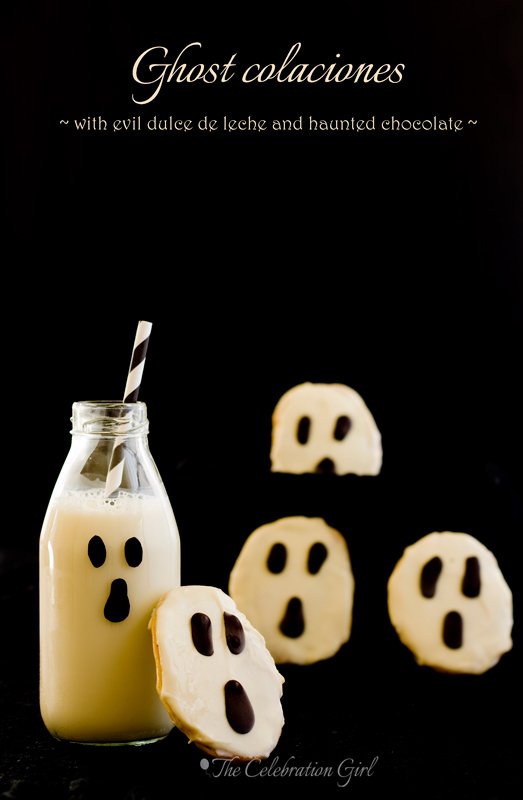
Good evening friends! Can you believe that it’s only 9 days until Halloween? I know I can’t, but I’m excited about it! This is going to be our children’s first full costume and trick or treat celebration, and I’m eager to see how they respond to all the activities at school.The holiday, I should note, is not celebrated in Cyprus (no trick or treating from door to door), but they will have a special party at their nursery and it promises to be fun. I bought their outfits earlier today…and I hope they will agree to wear them! 🙂
Halloween was not celebrated massively in Argentina either, when I was growing up, but my mother did organize a party every year at the institute for learning English as a second language, which she owned. So, every October 31st, her students and us (her children) dressed up in spooky costumes and celebrated it. It was all very funny because October is Springtime in Argentina and, of course, there were no pumpkins to carve at this time of the year, nor did any shops have any decorations that we could use, so we had to do as we could with a few sheets of black and orange cardboard paper. I still smile when I remember how crazy people thought we all we were, walking dressed as ghosts, witches, pirates and skeletons, on our way to the house where the party was held.
Things have changed in the last 20 years (20 YEARS!!), and Halloween parties are more popular, but, in the spirit of those first celebrations I attended, I thought it would be fun to use this opportunity to share with you the recipe for a delicious, classic cookie from Cordoba, Colaciones, and to “halloweenize” it ( I just invented that word :))
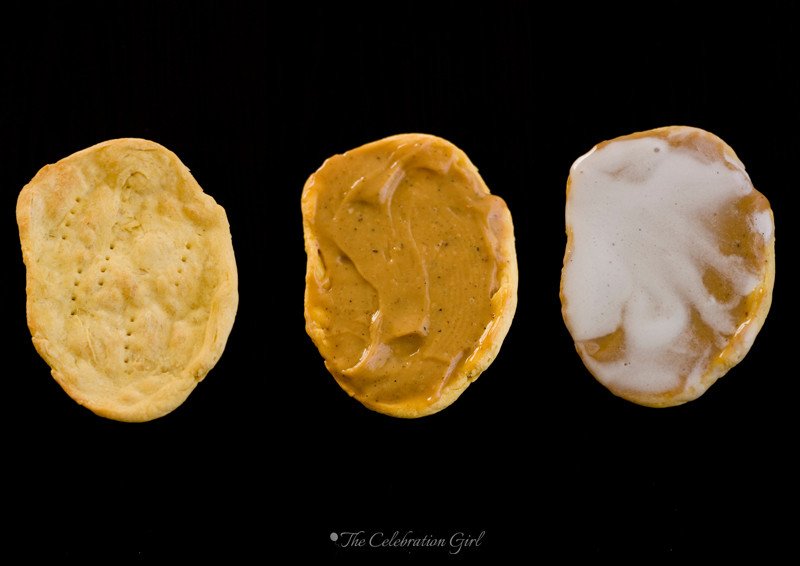
This recipe has been adapted from the one of a famous Argentinian pastry chef called Maru Botana (you can find the original one here), and it is the best one I ever tried. Colaciones’ dough is very peculiar: it doesn’t take any oil or butter, nor does it take any sugar or salt It is just a combination of eggs, egg yolks, flour and a white alcoholic beverage of your choice (the original recipe calls for cherry brandy, but you can also use another type of brandy or gin or vodka). Eggs are beaten, flour and brandy is added and then the dough is kneaded and shaped in the traditional way. One word of caution: do not put the dough in the freezer! I did it because I didn’t have time to finish making them in the same day, and when I thawed it, I had to start all over, because it had become too hard. If you need to make the colaciones in advance, it is better to prepare the dough and bake the cookies in one take. You can store the already baked shells in an airtight container (such as freezer bags), and then fill them with dulce de leche (as is traditional in Córdoba) or quince jam (as they do in some Northern cities of Argentina) and glaze them a few hours before it’s time to serve them.
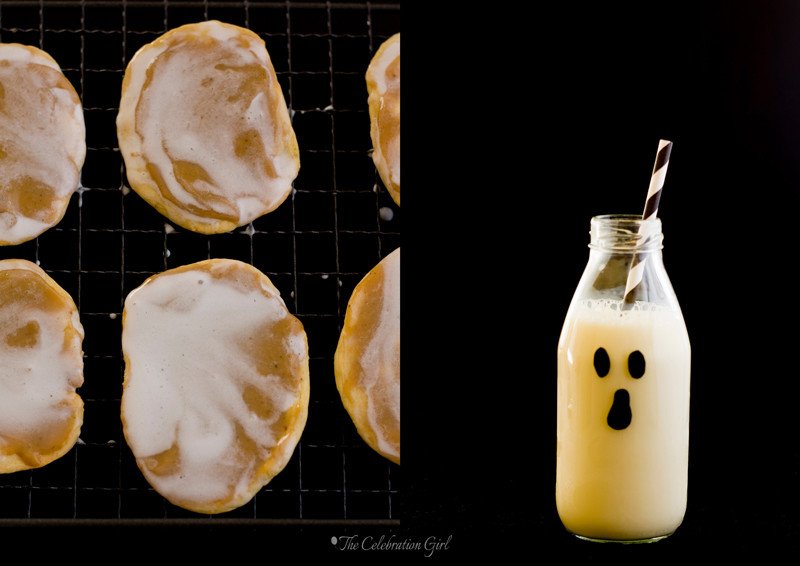
Colaciones’ traditional glaze is a simple combination of a beaten egg white, icing sugar and boiling water. In this occasion, however, I chose to cover them in white chocolate for a smoother, more even finish, because I didn’t want the dulce de leche to be visible. Then, I drew a ghostly face with dark chocolate, using just a regular teaspoon (no fancy decorating items required!). So, if you are looking for an easy, delicious, untraditional sweet for your Halloween celebrations, give colaciones a try! You will love them!
Here’s the recipe:
Colaciones cordobesas (makes 64 cookies of approximately 5 cms) Recipe adapted and translated from Maru Botana’s
Ingredients: 2 eggs, 4 egg yolks, 1 tablespoon of brandy/gin/vodka, 300 grs all purpose flour, 500 grs dulce de leche (if you can find dulce de leche repostero/baker’s dulce de leche, it is better, but any other will work as well), 1 beaten egg white, 2 cups of icing sugar, 2 tablespoons of boiling water (alternatively, if you want to glaze them with white chocolate, you will need approximately 600 grs and 200 grs dark chocolate to draw the spooky face in all 64 cookies).
Preparation: Beat eggs and egg yolks to the ribbon (it takes about 10 minutes). Add flour and brandy, mixing well, until you get a workable ball of dough. Knead the dough and extend it with a rolling pin. Cut the cookies using a round cookie cutter and then work each with your hands, to extend them and make them thinner (as thin as possible, or they will be too hard once baked). The dough is hard to work with, shaping the cookies takes some effort!. Once they are thin, place them on a baking tray covered with baking paper, and pinch them with a fork. Bake them at 175C for about 10 minutes. They will dry and curve in the oven and, once they do this, they are ready. Remove from the oven, let them cool well and fill with a teaspoon of dulce de leche. Next, prepare the glaze of your choice. For the traditional glaze, beat an egg white until firm, add two cups of sugar to “dry”the egg white and then, slowly, add the boiling water. I needed two tablespoons, but you may need more or less, so do it slowly. If you notice that the glaze is too thin and won’t cover the cookies properly, you may add more icing sugar. Note, however, the traditional glaze does not provide an all white, perfect coverage so, if that’s what you are aiming for, I suggest covering the cookies in white chocolate instead. Whichever glaze you chose, let it harden before drawing the spooky face on it.
Decoration: Melt dark chocolate and and let it cool down. Once it’s cool, draw a ghostly face on the cookies, by adding little bits of chocolate with a teaspoon.
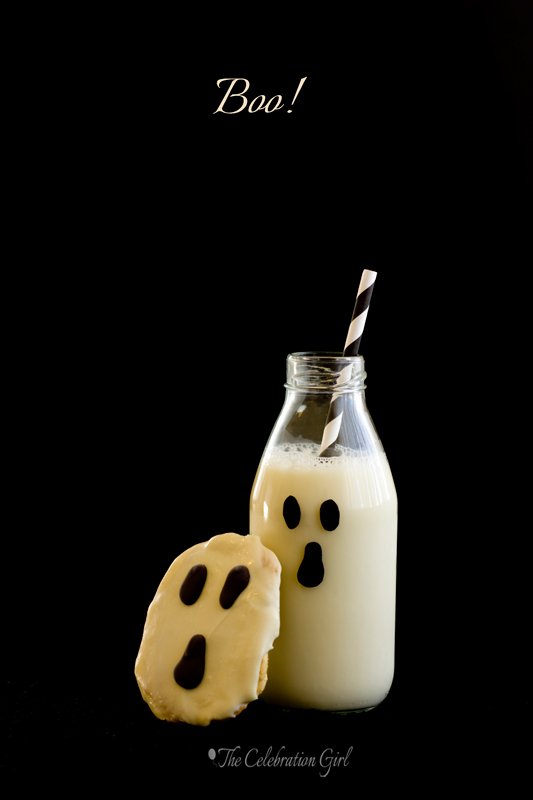
Con sabor latino…
Buenas noches amigos! ¿Pueden creer que faltan apenas 9 días para Halloween? A mí me resulta increible, pero en casa estamos super excitados al respecto porque esta va a ser la primera vez que Luka y Zoe van a festejarlo con disfraces y golosinas, y tenemos muchas ganas de ver cómo reaccionan ante todo el despliegue de actividades que están organizando en su escuela. En Chipre no se festeja Halloween masivamente, como en otros países, así que no hay pedidos de golosinas a los vecinos ni nada de eso, pero sí van a tener su primera fiesta en la escuela, y promete estar divertida. Esta mañana, sin ir más lejos, les compré sus primeros disfraces- ahora sólo queda esperar que ;es gusten y se los pongan!
Halloween tampoco se celebraba mucho en Argentina, cuando yo era adolescente, pero mi mamá sí organizaba una fiesta todos los años, en su instituto de inglés. Así que, cada 31 de octubre , sus alumnos y nosotros (sus hijos), nos disfrazábamos y lo celebrábamos. Era todo muy gracioso porque, como octubre es primavera en Argentina, no había zapallos que decorar, y al no ser una fiesta tradicional nuestra, tampoco había en los negocios golosinas especiales, ni decoraciones alegóricas, así que nos arreglábamos simplemente con algunas cartulinas negras y naranjas, y el talento de mi madre para transformar el salón en dos segundos, con lápices y tijeras. Escribo estos recuerdos y sonrío pensando en cómo la gente nos miraba como si estuvieramos locos, al vernos caminar hacia el instituto de inglés vestidos como brujas, fantasmas, y esqueletos.
Todo esto ha cambiado en los últimos 20 años (20 AÑOS!) y ahora Halloween es mucho más común pero, en honor a esos primeros festejos de mi vida, se me ocurrió aprovechar esta ocasión para traerles una receta tradicional Argentina (Cordobesa!) y “halloweenizarla” (sí, inventé esa palabra :))
La receta de hoy ha sido adaptada de la de Maru Botana, una famosa chef pastelera Argentina, y es sin dudas la mejor que he probado. La masa de las colaciones es muy peculiar: no lleva aceite, ni manteca, ni azucar, ni sal. Es sólo un conjunto de huevos, yemas, harina y algún licor blanco de su elección. La receta original de Maru lleva aguardiente de cerezas, pero yo la he hecho también con brandy, gin o vodka. El procedimiento consiste en batir mucho huevos y yemas (aproximadamente 10 minutos con batidora), hasta lograr el punto “letra”, que es cuando al levantar el batidor se forma una cinta de liquido que no se corta, y con la cual puede dibujarse sobre el resto de la preparación (=formar letras). Luego, se agregan harina y aguardiente y se forma n bollo de masa, que se estira, se corta y se da forma con las manos antes de llevar al horno. Aprovecho para hacerles una advertencia: no coloquen la masa en el freezer. Si no tienen tiempo de hacer todas las colaciones en un mismo día, es preferible que hagan la masa, y cocinen las galletitas en el momento, y luego las guarden en el freezer, ya cocidas, en un recipiente hermético o en bolsas especiales. Luego, pueden descongelarlas dentro del recipiente, y retirarlas unas horas antes de servir, para rellenarlas con dulce de leche (como en Cordoba) o con dulce de membrillo (como en algunas provincias del norte de Argentina) y cubrirlas con glaseado.
El glaseado tradicional de las colaciones es uno muy simple a base de clara batida a punto nieve, azucar impalpable y agua hirviendo. En esta ocasión, sin embargo, yo elegí cubrirlas con chocolate blanco para darles un finalizado más parejo y uniforme, ya que no quería que se transparentara el dulce de leche del relleno. Luego, derretí chocolate negro y dibujé la carita del fantasma con el mismo, usando una cuchara de café (no hace falta manga ni nada especial!). Si estan buscando una receta diferente para sus celebraciones, prueben estas colaciones que seguro les encantan!
Para ver la receta original, hagan click en ESTE LINK. Normalmente no suelo publicar recetas de otros autores y el unico motivo por el que lo hago en esta ocasión es porque he agregado notas a la forma de preparala y precisado cantidades de glaseado, que quiero compartir con ustedes, y creo que sería muy confuso tener que ver dos páginas al mismo tiempo para entender una receta. Sin embargo, no dejen de ver la pagina de Maru, porque tiene unas recetas fantasticas y precisas, que vale la pena intentar!
Colaciones cordobesas (para 64 galletitas, aproximadamente), adaptada de una receta original de Maru Botana
Ingredientes: 2 huevos, 4 yemas, 1 cucharada sopera de brandy/aguardiente/gin/vodka, 300 grs de harina común (todo uso), 500 grs de dulce de leche (si consiguen dulce de leche repostero, mejor, pero si no el otro sirve igual), 1 clara batida a nieve, 2 tazas de azucar impalpable, 2 cucharadas soperas de agua hirviendo. Si quieren cubrirlas con chocolate blanco, como hice yo, necesitaran 600 grs del mismo para todas las galletitas, y 200 grs de chocolate negro para dibujar la carita fantasmagórica.
Preparación: Batan los huevos y las yemas a punto letra, aproximadamente 10 minutos con batidora. Agregue el brandy y el harina, de a poco, integrando bien, hasta que pueda formar un bollo de masa con las manos. Estiren con palote de amasar y corten circulos con un cortante redondo (yo use uno de 4 cms). Luego, trabajen la masa con los dedos (vean la foto de más arriba), estirandola para que quede bien finita. Cuiden que la masa quede bien fina, porque si está demasiado gruesa, las colaciones quedarán duras unas vez cocidas. Les advierto que la masa es dura y darles forma requiere esfuerzo! Una vez que esten bien finitas, coloquenlas en una placa para horno cubierta con papel de hornear, y pinchenlas con el tenedor. Cocinenlas a 175C durante aproximadamente 10 minutos. En el horno las galletitas van a secarse y arquearse y, una vez que lo hagan, estarán listas. Retirenlas, dejenlas enfriar, y luego rellenenlas con una cucharada de dulce de leche cada una. Preparen el glaseado batiendo una clara a punto nieve. Agreguen 2 tazas de azucar impalpable, para “secar” la clara, y luego, muy poquito a poco, agreguen el agua hirviendo. Tengan cuidado aquí de que el glaseado no les quede muy “chirle” o “fino”, porque se ser asi no cubrirá bien las colaciones. Si se pasan con el agua, no se hagan problemas, agreguen un poco mas de azucar. Tengan en cuenta que el glaseado tradicional no provee una cobertura perfecta, el dulce de leche suele transparentarse un poco. Si las quieren bien blancas, opten mejor por bañarlas en chocolate blanco, como hice yo.Sea cual sea el glaseado que elijan, recuerden dejarlo secar bien, para que endurezca, antes de decorar con la carita de chocolate.
Decoración: Derritan el chocolate amargo/ semi amargo a baño maría, y dejenlo enfriar. Una vez frío, coloquen un poco de chocolate en una cuchara de té y dibujen, despacito, una carita fantasma sobre las colaciones (es muy facil, es solo cuestion de hechar pequeñas cantidades de chocolate muy de a poco, moviendo la cuchara a lo largo, para “estirar” ojitos y boca)
Do you celebrate Halloween? What do you normally bake for the occasion?
Celebran Halloween? Qué dulces suelen preparar para esta ocasión?
by Marcela M. | Jul 21, 2012 | Blog, cookies, Recipe Box, Recipes, South America, Sweets, Travel, Uncategorized
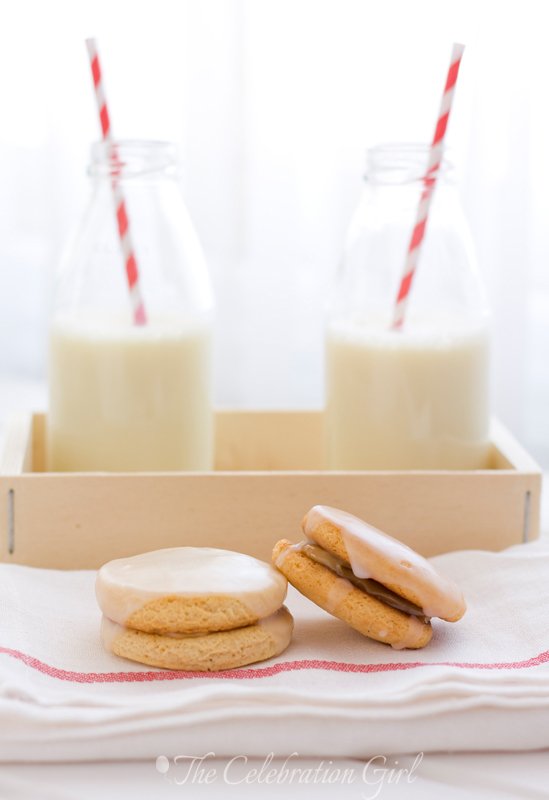
Good evening dear friends! I hope you are having a lovely weekend.
Days have been incredibly HOT in Nicosia this past week, with temperatures ranging from 40 to 45.5 degrees celsius. Summer is definitely here and this means doing our best to minimize as much as possible the heat that comes into the house. This is why we clean early in the morning, and then try to keep all window shutters down, to turn the stove on as little as possible and, you guessed it, we avoid baking! We tend to opt for meals that require minimal cooking, such as fresh salads, and, for dessert, we eat fruits and simple home-made fruit lollies.
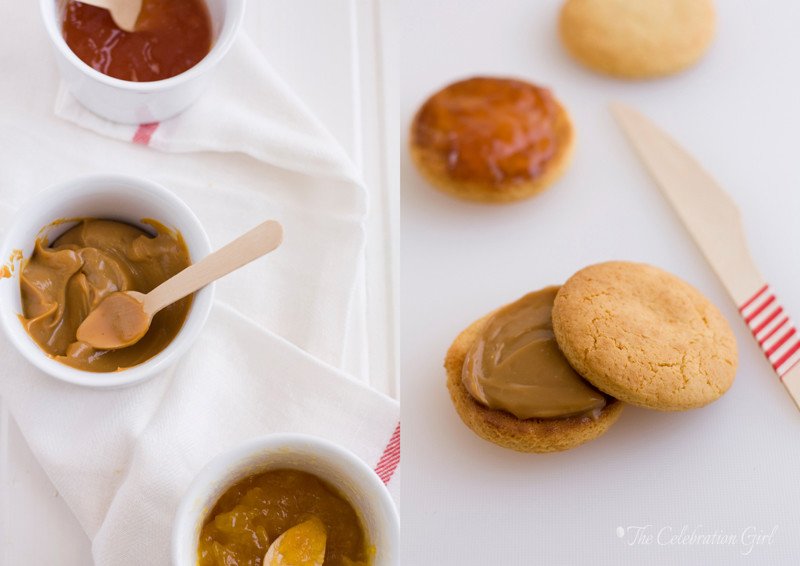
Sometimes, however, we do crave a little baked treat and, for those occasions, these alfajores are perfect: they are incredibly easy and they take only 5 to 7 minutes in the oven to be ready. After they have cooled down, they are sandwiched with fruit jam or dulce de leche and covered in the simplest glaze of all: icing sugar to which we just add a few tablespoons of boiling water and a sprinkle of lemon juice. They couldn’t be easier!
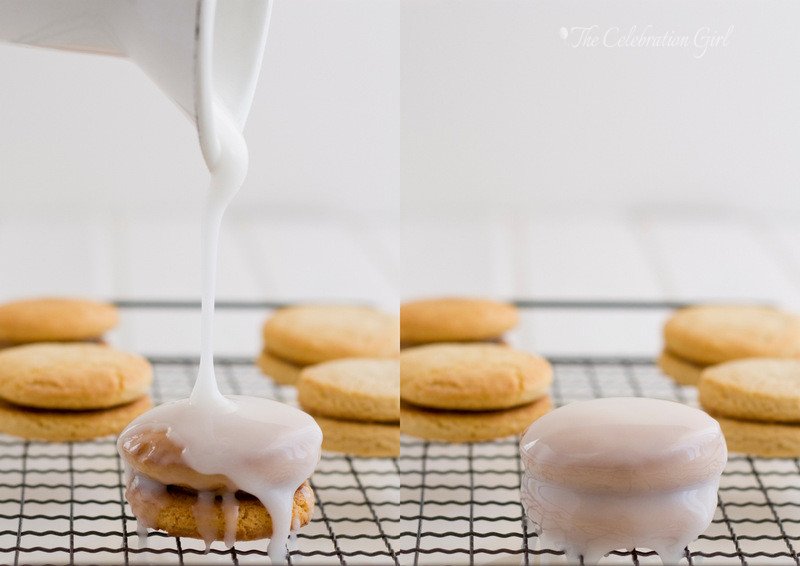
You may have noticed that I called these alfajores “semi cordobeses” , and there is a reason for that. I had been looking for a while for a recipe of the particular type of alfajores from my home city. I never had one because, when I lived there, I always bought them from a nearby store but, now that I live abroad and that I have children whom I would like to introduce to my culinary traditions, I wanted to be able to make them at home.
The search, however, proved to be difficult. It turns out that Argentina’s cocina criolla (créole cuisine) is famous for being “unreliable” or “moody”. Now, I honestly refuse to attribute human characteristics to any recipe and I believe, instead, that what happens is product of the typical way recipes are transmitted back home: as part of family heritage. Recipes are learned, first, by watching our elders prepare them at home and, later, by making them together with them when we are older. At my own home, for example, we rarely measured ingredients and recipes were rarely written down. We just knew how they were supposed to turn out and how to fix common problems, because we had been making them our whole life.
This reminds me of an anecdote from my grandmother. One day, back in 1997, I was about to leave Argentina for a few months when I realized that I had never written down some of her delicious staple recipes and that I would not necessarily remember how they were done because they were not everyday dishes. So I sat down with her, in her kitchen, armed with a notebook and a mate, and she started trying to explain to me how the recipes were done. Our dialogues went more or less like this:
Me: So, let’s see, “rosquitas“. What ingredients do they take?
Grandma Antonia: 6 eggs, 3 tablespoons of alcohol, 1/2 kilo of flour.
Me: And how do I make them?
Grandma Antonia: Just mix everything until you get a smooth dough. But if you feel that it turns out to be too dry, add another egg.
Me: (confused) But how do I know if the dough is too dry and I should add another egg or if I should just keep mixing??
Grandma Antonia: I don’t know! I just know!
Of course, we ended up making rosquitas together and I took many more notes than the ones initially provided by my grandmother. She knew so well how to make the recipe that it was hard for her to put herself in my shoes, or in the shoes of anyone who, well, just didn’t know everything that she did.
Most of the recipes I have from my home are like that. They mention “a drop of milk”, “a bit of flour”, or they get started with 100 grs of chocolate but then add unmeasured extra quantities of it as the preparation progresses, according to how we know the dish is supposed to turn out because we made it countless times before. This is perfectly okay when recipes are transmitted within families but it becomes a problem when one has never seen the dish being prepared before. People tend to transmit the initial ingredients and the basic procedures but, more often than not, they simply forget to pass down vital information that one only acquires when making the food with them. Then, of course, fiascos become very common!
Let me just tell you that I had many of those fiascos before achieving this recipe (which gave me a few headaches too!) and I still haven’t found a good one for our traditional colaciones. What’s more, I don’t think my search for the real alfajor cordobés is over yet. These are delicious cookies, the texture of which does resemble that of our traditional sweets…but the taste is not quite “it”, in my opinion, and that is the reason I called them “semi-cordobeses”. That being said, do try them, because they are really, really tasty!
Here is the recipe:
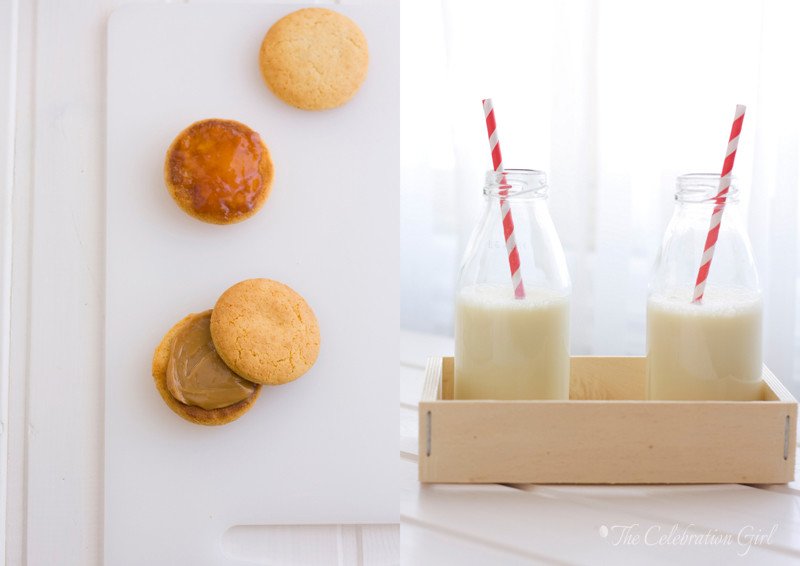
Ingredients (For 25 alfajores of 4 cms diameter/ 50 single cookies)
– 500 grs all purpose flour (0000)
– 10 grs amonium bicarbonate (or 12 grs sodium bicarbonate, which is less smelly)
-10 grs baking powder
– 120 grs soft butter or margarine
– 2 eggs (I used M)
– 200 grs sugar
– 50 grs honey
– 15 grs malt extract (I used barley malt extract, which I found in the organic food section of my local supermarket)
– Fruit jam of your choice or dulce de leche, for sandwiching the cookies. I used quince jam, apricot jam and dulce de leche, for more variety. Traditional jams are quince, apricot, apple and pear.
– 4 cups of icing sugar
– 1 tablespoon of lemon juice
– 3/4 cup of boiling water (or 12 tablespoons)
Preparation:
1) Mix flour, baking powder and bicabonate.
2) Pour flour mix on the kitchen counter and make a hole in the middle
3) Add butter, eggs, honey, malt extract and sugar in the hole. Start mixing the wet ingredients with your hands, and once this is done, start incorporating the flour, little by little, until you get a uniform dough.
4) Cover the dough in plastic wrap and put in the refrigerator for 20 minutes.
5) In the meantime, prepare your baking sheets by lining them with baking paper.
6) A few minutes before removing the dough from the refrigerator, preheat the oven to 250 degrees C (maximum)
7) Roll the dough 1/2 cm wide and cut circles using a cookie cutter. Place the circles on baking sheets and put them in the freezer for 5 minutes. NOTE: The cookies grow in the oven, so place them apart on the baking sheet or they will join one another. Also, do not skip the freezer part or they will lose their shape!
8) Bake in a hot oven for 5 to 7 minutes, until they barely begin to brown. Be careful, they brown easily!
9) Remove from the oven, transfer to a wire rack and let cool completely
10) Add one tablespoon of jam or dulce de leche to one cookie, and sandwich it by placing another one on top. Now you have an alfajor! Continue until all cookies have been sandwiched together.
11) Prepare the glaze by adding the boiling water and lemon juice to the icing sugar and mixing well, until no lumps remain.
12) Place the alfajores on a wire rack and pour the glaze over them. Let the glaze cool and harden, and eat.
You may store them in the freezer for up to 3 months. I hope you will like them!

Buenas noches queridos amigos! Espero que esten pasando un hermoso fin de semana!La semana pasada tuvimos unos días increíblemente calurosos en Nicosia, con temperaturas que iban de los 40 and los 45.5 grados centígrados. El verano se ha instalado aquí definitivamente y eso significa, para nosotros, hacer todos los esfuerzos posibles por minimizar la entrada de calor a la casa. Por este motivo, limpiamos bien temprano a la mañana y luego intentamos mantener todas las persianas bajas, cocinar lo menos posible y, se imaginarán, evitamos prender el horno! Así que optamos por comidas livianas, que requieran mínima cocción, como ensaladas frescas, muchas frutas y helados palito de fruta, bien simples.A veces, sin embargo, nos agarren esos ataques de algo dulce-dulce y, para estos casos, estos alfajores son perfectos: son increiblemente fáciles de hacer y sólo requieren 5 a 7 minutos de horno. Una vez que estan cocidos y ya se han enfriado, se los une con mermelada de frutas o dulce de leche y se los cubre con el baño más sencillo que existe: azucar impalpable a la que se le agrega agua hirviendo y un poquito de limón. No pueden ser más sencillos!Seguramente habrán notado que llamé a estos alfajores
semi cordobeses y esto tiene una razón de ser. Hace ya bastante venía buscando una buena receta de los alfajores tradicionales de mi terruño (
de los que hablé en este post). Cuando vivía en Argentina nunca los hice porque, en caso de antojo, no tenia más que ir al kiosco a comprar uno, pero ahora que vivo en el exterior y que quiero transmitirle a mis hijos mis tradiciones culinarias, comencé a querer poder hacerlos en casa.
La búsqueda, sin embargo, no fue sencilla. Descubrí, entre otras cosas, que la cocina criolla tiene fama de “poco confiable” “traicionera” o “temperamental”. Ahora bien, honestamente me niego rotundamente a asignarle a una comida caracteristicas humanas y creo que lo que en realidad ocurre, que el motivo por el que las recetas “no siempre salen bien”es otro, y está ligado a la forma en que se transmiten las recetas: como parte del acervo familiar de cada uno. Las recetas no se escriben, se aprenden mirando a nuestros mayores, cuando somos chicos, y haciéndolas con ellos, cuando crecemos. En mi casa, por ejemplo, rara vez mediamos ingredientes meticulosamente, ni escribiamos instrucciones detalladas. Simplemente
sabíamos cómo debía quedar el plato y cómo solucionar posibles problemas, porque lo veníamos haciendo toda nuestra vida.
Escribo estas líneas y recuerdo una anecdota, muy ilustrativa, que involucra a mi abuela. Un día, allá por el año 1997, días antes de que yo fuera a partir de Argentina por unos meses, caí en la cuenta de que nunca había anotado algunas de aquellas deliciosas recetas que mi abuela no hacía tan frecuentemente y que, por lo tanto, yo no conocía de memoria. Así que me senté con ella en la cocina de su casa, con un cuadernito que aún conservo, y una pava de mate, a intentar que ella me explicara su recetario personal. Nuestros dialogos terminaron siendo algo más o menos asi:
Yo: Bueno, a ver, rosquitas. ¿Qué ingredientes llevan?
Abuela Antonia: 6 huevos, 3 cucharadas de alcohol, 1/2 kilo de harina
Yo: Y como las hago?
Abuela Antonia: Mezclá todo hasta que te quede una masa suave. Pero si ves que la masa está muy seca, agregá un huevo
Yo: (confundida)…pero cómo sé si la masa está seca como para agregarle un huevo o si sólo tengo que seguir trabajandola
Abuela Antonia: ah, no sé! Yo sólo sé!
Obviamente terminamos haciendo las rosquitas juntas y en ese momento tomé muchisimas más notas para complementar las instrucciones iniciales dadas por mi abuela. Ella conocía tan bien cómo hacer la receta que le resultaba dificil ponerse en mi lugar, o sea, en el lugar de una persona que no supiera aquello que ella sabía tan a la perfección.
La mayoría de las recetas que traigo de casa son así. Hablan de “un chorrito de leche”, “un poquito de harina” o mencionan 100 grs de chocolate, pero no cuentan todos esos “poquitos extra” que se van agregando durante la preparación, conforme cómo el plato “debe quedar”. Esto funciona de maravillas con las recetas familiares, porque uno las conoce de memoria y no necesita una receta detallada, pero se transforma en un problema para alguien que nunca hizo el plato antes. La gente tiende a transmitir sólo los ingredientes iniciales y los procedimientos básicos, olvidando transmitir tambien, la mayor parte de las veces, aquellos datos extra que son vitales para obtener un buen resultado. Y en esos casos, claro, los fiascos son momumentales y uno se queda mirando el horroroso resultado final y preguntándose qué habrá ocurrido.
Dejenme decirles que, en la busqueda de esta receta he tenido muchos de esos fiascos, que, aun esta receta misma me dio varios dolores de cabeza al comienzo, hasta que logré “rellenar los espacios vacíos”, y que aún no logro dar con una buena receta de colaciones. Y más aún, todavía no considero que mi búsqueda del perfecto alfajor cordobés haya culminado. Estos alfajorcitos son deliciosos, y tienen una textura muy similar…pero el gusto no es exactamente el del alfajor cordobés tradicional, en mi opinión, y es por este preciso motivo que los llamé “semi-cordobeses”. Dicho esto tambien les digo que no dejen de probarlos porque son realmente muy, muy ricos!
Aquí está la receta:
Ingredientes
– 500 grs de harina cuatro ceros
– 10 grs de bicarbonato de amonio o 12 grs de bicarbonato sódico ( que es menos oloroso)
– 10 grs de polvo de hornear
– 120 grs de margarina o manteca
– 2 huevos
– 200 grs de azucar
– 50 grs de miel
– 15 grs de extracto de malta
– mermelada de frutas o dulce de leche para unir las tapitas. Yo usé mermelada de membrillo, de damascos y dulce de leche. Las mermeladas tradicionales son membrillo, damascos, pera y manzana.
– 4 tazas de azucar impalplable
– 3/4 taza de agua hirviendo
– 1 cucharada de jugo de limón
Preparación:
1) Mezcle la harina con el polvo de hornear y el bicarbonato
2) Coloque la harina sobre la mesada en forma de corona (haciendo un huevo en el medio)
3) Agregue, en el hueco mencionado, la manteca o margarina, los huevos, el azucar, la miel, y el extracto de malta. Mezcle los ingredientes húmedos con las manos y, una vez incorporados, comience a agregar de a poco el harina, moviendola hacia el centro en pequeñas cantidades, hasta formar una masa uniforme.
4) Cubra el bollo de masa con papel film y lleve a la heladera por 20 minutos.
5) Mientras tanto, prepare las placas para horno recubriendolas con papel de hornear (antiadherente).
6)Unos minutos antes de sacar la masa de la heladera, precaliente el horno a maximo/250C
7) Saque la masa de la heladera y estirela con palote de amasar hasta que tenga un ancho de 1/2 cm. Corte circulos de aproximadamente 4 cms de diametro, coloquelos sobre la placa y lleve la placa al freezer por 5 minutos. NOTA: las tapitas crecen en el horno, asi que coloquelas suficientemente separadas la una de la otra o se unirán al cocerlas. Asimismo, no omita ponerlas en el freezer o perderan la forma!
8) Cocine las tapitas en horno fuerte por 5 a 7 minutos, hasta que esten apenas doradas. Tenga cuidado, se doran muy rápido, vigílelas!
9)Retire del horno, transfiera a una rejilla, y deje enfriar totalmente.
10) Una vez que las tapitas estén frias, unte la mitad con una cucharada de la mermelada/dulce de su elección, y cierrelas con las tapitas restantes, haciendo un sandwich. Una vez haga esto, usted tendrá en sus manos alfajores!
11) Prepare el baño de azucar agregando el agua hirviendo y el limon al azucar impalpable y revolviendo bien hasta que no queden grumos.
12) Coloque los alfajores sobre una rejilla y cubralos con el baño de azucar. Deje que el baño se seque y endurezca y disfrute!
Pueden guardarlos en el freezer por 3 meses. Espero que les gusten!

Have a wonderful weekend and a great start of the new week!

































